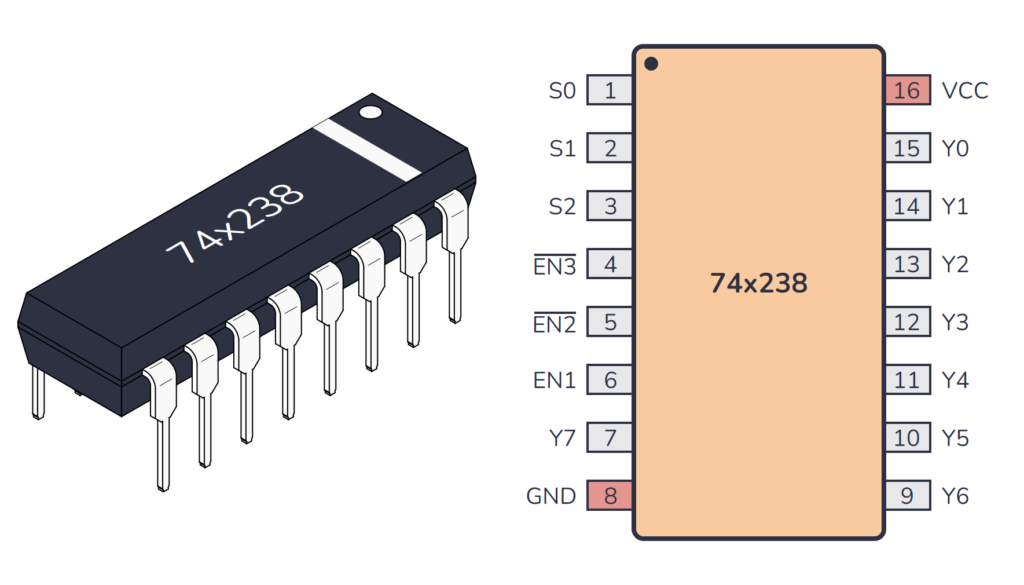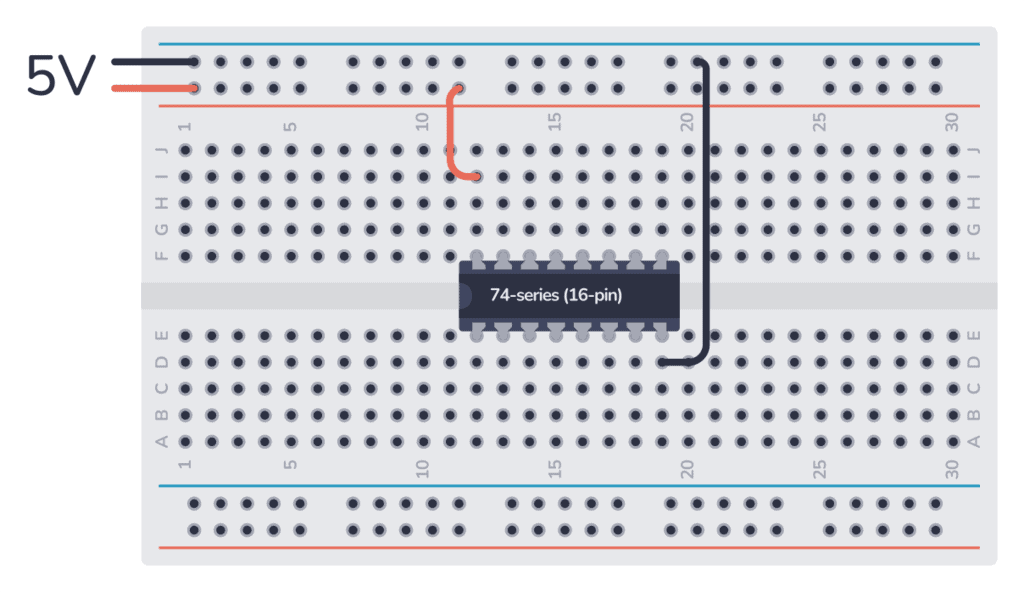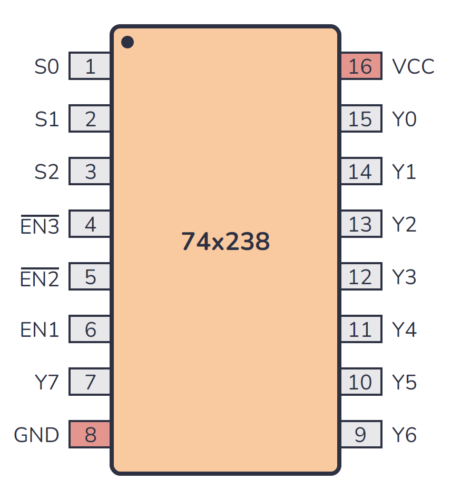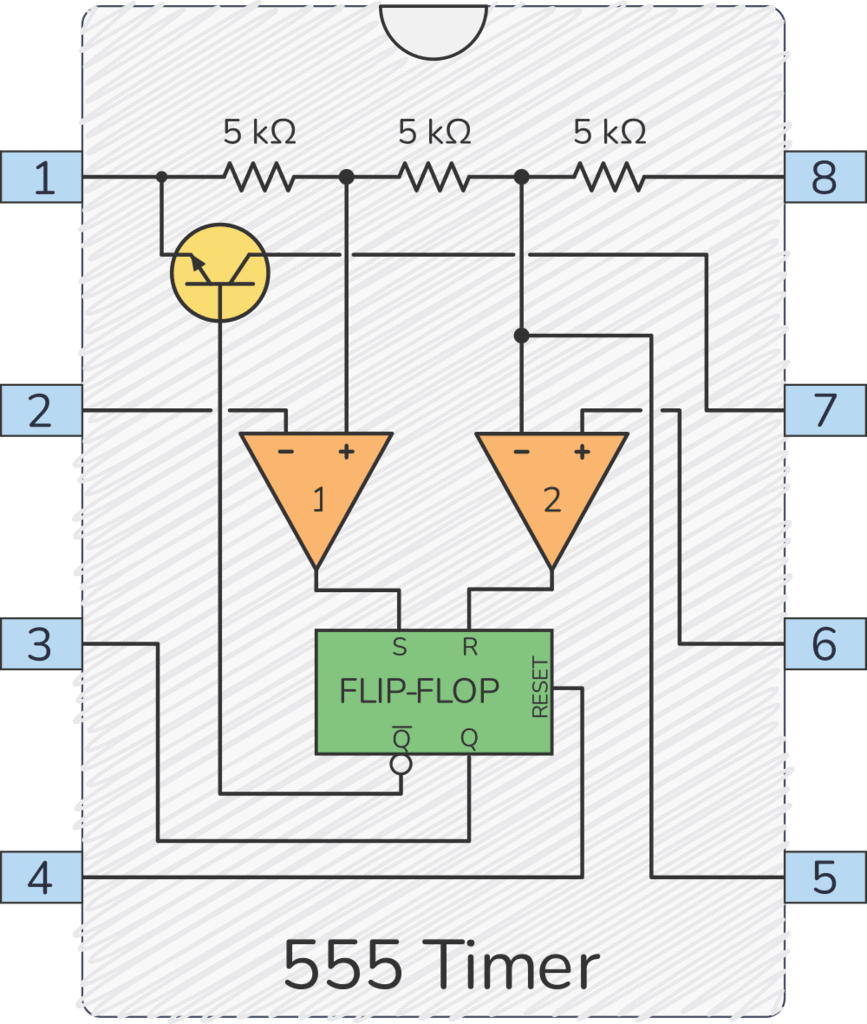The 74×238 (ex 74HC238) is a chip that contains a 3-to-8 line decoder/demultiplexer. This versatile component takes 3 binary inputs and decodes them into 8 distinct outputs, where only one output is active at a time.
In this guide, you’ll learn the things you need to know about this chip in order to use it in your own projects.

What does the 74HC238 / 74LS238 do?
The 74×238 is a 3-to-8 line decoder/demultiplexer. It takes three binary inputs (A, B, and C) and translates them into eight outputs (Y0 to Y7). Each output corresponds to a specific combination of the input values, and only one output is LOW at a time, depending on the input.
The chip also has three enable inputs (G1, G2A, and G2B). For the chip to work, G1 needs to be HIGH while both G2A and G2B need to be LOW. When these conditions are met, the chip decodes the input combination to activate one of the outputs by setting it LOW and keeping the rest HIGH.
The 74×238 is commonly used in applications for memory address decoding or routing signals in digital circuits.
How To Use This Chip
The 74HC238 comes in a 16-pin package, and you need to connect it to power before you can use it. Most 7400 ICs support a VCC voltage of 5V. One difference between the HC and LS version of the chip is that the 74HC238 supports 2V to 6V, while the 74LS238 only supports 5V.
74HC chips can normally supply a maximum of 4 mA from an output pin. If you’re using the 74LS version, the maximum current you can pull out of one output pin is 0.4 mA when the pin is high (sourcing) or 8 mA when the pin is low (sinking).
But these values can differ between models, so check the datasheet of your model to verify.

Build Something Useful This Evening
This gadget lets you use any IR remote-control to control your lamp, garden lights, heater oven, garage door, or anything else.
Once you’ve connected it to power, you can use the Decoder/Demultiplexer inside.

74×238 Pinout
The 74×238 has 16 pins and contains 1-of-8 noninverting decoder/demultiplexer laid out as shown in the pinout diagram below:

| Pin Name | Pin # | Type | Description |
|---|---|---|---|
| S0 | 1 | Input | Select input (bit 0) for addressing the outputs. |
| S1 | 2 | Input | Select input (bit 1) for addressing the outputs. |
| S2 | 3 | Input | Select input (bit 2) for addressing the outputs. |
| EN3 | 4 | Input | Enable input 3 (active low). |
| EN2 | 5 | Input | Enable input 2 (active low). |
| EN1 | 6 | Input | Enable input 1 (active high). |
| Y7 | 7 | Output | Output bit 7 from the decoder. |
| GND | 8 | Power | Connect to ground (GND). |
| Y6 | 9 | Output | Output bit 6 from the decoder. |
| Y5 | 10 | Output | Output bit 5 from the decoder. |
| Y4 | 11 | Output | Output bit 4 from the decoder. |
| Y3 | 12 | Output | Output bit 3 from the decoder. |
| Y2 | 13 | Output | Output bit 2 from the decoder. |
| Y1 | 14 | Output | Output bit 1 from the decoder. |
| Y0 | 15 | Output | Output bit 0 from the decoder. |
| VCC | 16 | Power | Positive power supply. Connect to +5V power. |
Alternatives and Equivalents for 74HC238 / 74LS238
There are many versions of the 74×238 chip. They all have the same functionality, but with different specifications such as supported voltages and maximum current output.
Here’s a list of a few equivalents of this chip:
- 74HC238 (High-speed CMOS)
- 74HCT238 (High-speed CMOS, TTL compatible)
- 74LS238 (High-speed TTL)
- 74LVC238 (Low Voltage TTL)
- 74AC238 (Advanced CMOS)
- 74ALS238 (Advanced Low-Power Schottky TTL)
- 74F238 (Very High Speed)
- 74C238 (CMOS, similar to the 4000-series)
Some manufacturers also add a prefix, such as the SN74HC238 and SN74LS238 by Texas Instruments.
Can’t find the 74×238 anywhere? Then try one of the following IC alternatives:
- 74×137 – 3-to-8 line decoder/demultiplexer.
- 74×138 – 3-to-8 line decoder/demultiplexer.
- 74×139 – Dual 2-to-4 line decoder/demultiplexer.
- 74×237 – 3-to-8 line decoder/demultiplexer.
- CD4028 – BCD-to-decimal decoder.
- CD4029 – BCD-to-decimal decoder with latch.
If you can’t find the 74×238 IC in your local electronics store, don’t worry, you’ll most likely find it in one of the stores listed on this page of online stores where you’ll find components and tools for all your electronics projects.
Datasheet for the 74LS238 and 74HC238 chips
Download the PDF datasheet for your version of the 74×238 here:

Get the 555 Timer Cheatsheet
A super helpful reference that makes it easy to design circuits, so that you can build oscillators, timer circuits, and more in no time.

